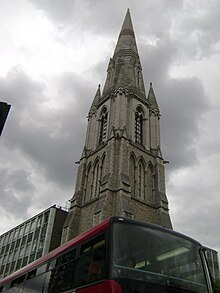Lincoln Memorial Tower

The Lincoln Memorial Tower or Lincoln Tower is a
Origins

The Lincoln Tower is built on the site of an orphanage for females, founded in 1758. When the orphanage closed in the mid nineteenth century, its site was acquired by trustees of the
The pastor of Surrey Chapel at the time was the energetic Christopher Newman Hall who had lectured and written extensively in support of Abraham Lincoln and abolition of slavery during the American Civil War. He raised funds in America for a permanent International Memorial in London, to Abraham Lincoln, and incorporated this into plans for redevelopment of the former orphanage site.
The Lincoln Tower was opened on 4 July 1876, the centenary of
Architecture and design
The original design by the architect E. C. Robins, developed in 1873, would have placed the tower and spire as an elevated structure above the centre of the new Congregational chapel. This was adapted in the final scheme by architects Paull and Bickerdike, who kept much of the original design and detailing of the building complex as a whole, but gave greater prominence to the Lincoln Tower. This became a stand-alone building with its own ground floor and entrances, though still integral to the complex. As more memorial funds were raised, the new architects, like E. C. Robins before them, added a lofty spire; raising the tower 200 feet high. The spectacular spire incorporated Robins' concept for an architectural version of 'stars and stripes' - the use of a polychromatic colour scheme of red and white stones.
On the Tower's north entrance, above the apex of a large archway, a stone was added bearing the title Lincoln Tower. Under the paved basement the coffin of preacher Rowland Hill was re-located from Surrey Chapel, with a tablet inset into the interior wall above. There was another tablet in memory of his successor, James Sherman, with a still larger tablet giving the name and purpose of the tower – to commemorate emancipation by the martyred Lincoln, the contribution of half the cost of the tower by American citizens, and as a pledge of international brotherhood.
The completed tower, built of
Modern context

Much of the Christ Church complex was destroyed in the
Today, the complex, with its integral Christ Church and Upton Chapel form a modernist backdrop to the surviving
See also
- Lincoln Memorial
- Abraham Lincoln Memorial Garden
- Abney Park Cemetery
- List of buildings and monuments honoring presidents of the United States in other countries
References
- ^ Historic England. "TOWER OF FORMER CHRISTCHURCH AND UPTON CHAPEL (1081059)". National Heritage List for England. Retrieved 6 September 2017.
